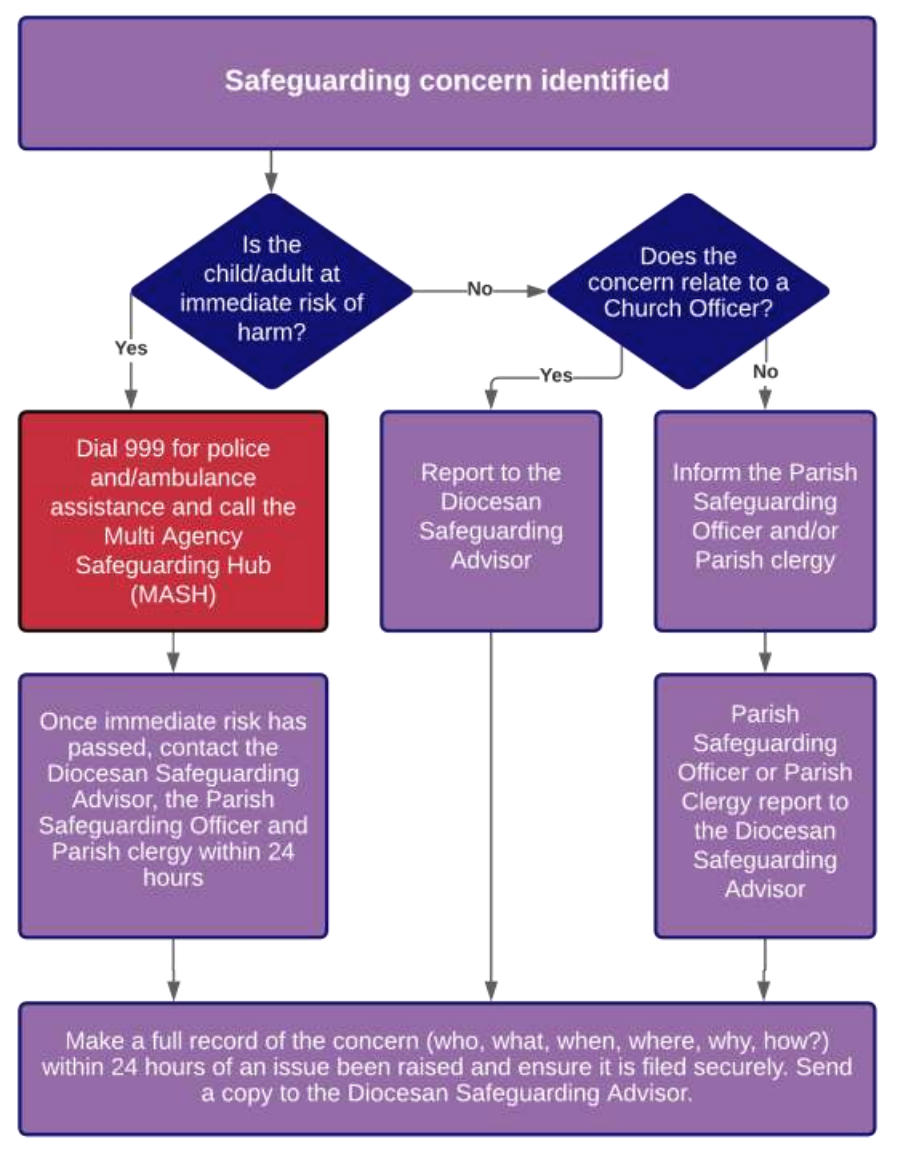There are a number of resources you can download for use within a parish context.
Policy for Responding to Domestic Abuse here.
Please be aware that the Channel Islands have different documents so please contact the respective island Safeguarding Lead for more information (see information in the Channel Island heading below).
All other safeguarding concerns within a parish should be brought to the attention of the Parish Safeguarding Officer (PSO), Church Safeguarding Officer (CSO in Jersey) or parish priest in the first instance. They can then seek further guidance from one of the Diocesan Safeguarding Advisors (DSA), contact details listed above, and refer to statutory agencies if appropriate.
Here is a flowchart showing what to do if you have a concern.

If your concern relates to the PSO, CSO or parish priest, please contact the DSO directly. There may be other occasions where someone may have a safeguarding concern but does not want to discuss this within a parish context. If this is the case, the DSA can be contacted directly.
Download the Model Parish Safeguarding Policy.
The legal transfer will be enacted on the receiving of the Order in Council during 2022.
More information regarding safeguarding on the respective Islands can be accessed here: Deanery of Guernsey (including Alderney and Sark) and the Deanery of Jersey.
The Channel Islands follow National Church of England safeguarding guidance and policies unless their own Island legislation dictates otherwise. Both Islands have their own Safeguarding Handbook (Guernsey) and Safeguarding Policy (Jersey) which can be found on their respective Deanery websites.
Safeguarding contacts:
Guernsey
Jersey
Requirements for your website
Safeguarding arrangements
A parish website must have a page/section called ‘Safeguarding’ which should include:
-
The contact details of a local person/s who can offer safeguarding help and who knows how to respond appropriately to a safeguarding concern or allegation. This could be a phone number or email for the Parish Safeguarding officer, the incumbent or someone who is trained to respond to Safeguarding concerns. For example: John Smith, safeguarding@stjohnschurch.co.uk
- The details of how to contact the Diocesan Safeguarding Team: safeguarding@salisbury.anglican.org or 01722 438651
There are two options:
- To display the safeguarding arrangements on the front page
- To provide a ‘Safeguarding’ link on the front page.
With option 2, the ‘Safeguarding’ link should be displayed in a prominent location (not hidden behind a menu). The safeguarding arrangements should be clearly visible once the link is clicked (without the need to click through to anything else).
If a parish has its own website, the ‘front page’ means the home page.
If a parish shares a website with other parishes, there are two choices. The ‘front page’ can mean:
- The home page of the website; or
- The main page for the parish.
The above ‘minimum requirements’ do not apply to A Church Near You, community websites or social media pages, but, we do encourage all our churches to follow best practice.
The aim of the Church of England is to make churches safer and also to create safe places where people feel able to disclose abuse beyond the church (e.g. at home, school or work).
Other information on parish websites
In addition to the ‘minimum requirements’, consider displaying:
- If your query is urgent or out of hours (5pm Friday to 10pm Sunday), please contact thirtyone:eight on 0303 0031111.
- “Call 999 if a child or adult is in immediate danger of significant or serious harm”
- A link to the parish safeguarding policy
- A link to the safeguarding section of the diocesan website
The phone numbers and websites to the following places:
- Safe Spaces – 0300 303 1056 Home - Safe Spaces England and Wales
- NSPCC – 0808 800 5000 NSPCC | The UK children's charity | NSPCC
- Childline – 0800 1111 Childline | Childline
- Stop it Now – 0808 1000 900 https://www.stopitnow.org.uk/
- NAPAC – 0808 801 0331 NAPAC - Supporting Recovery From Childhood Abuse
- Samaritans – 116 123 Samaritans | Every life lost to suicide is a tragedy | Here to listen
- Family Lives – 0808 800 2222 Parenting and Family Support | Family Lives
- National Domestic Abuse Helpline – 0808 2000 247 Homepage - National Domestic Abuse Helpline
- Hourglass – 0808 808 8141 Hourglass Services | Hourglass
A Church Near You
Every parish has its own section on A Church Near You which can be updated by a local editor. Whether or not the church has its own website, we encourage you to add a ‘Safeguarding’ page to the parish section on A Church Near You.
Community websites
If the church has a page on a community website, consider displaying some safeguarding information there too.
Social media
If the church has a page on Facebook or other social media sites, we encourage you to add safeguarding contact information or a link to this information.
If you have any further questions, please do not hesitate to contact your Diocesan Safeguarding Team.


